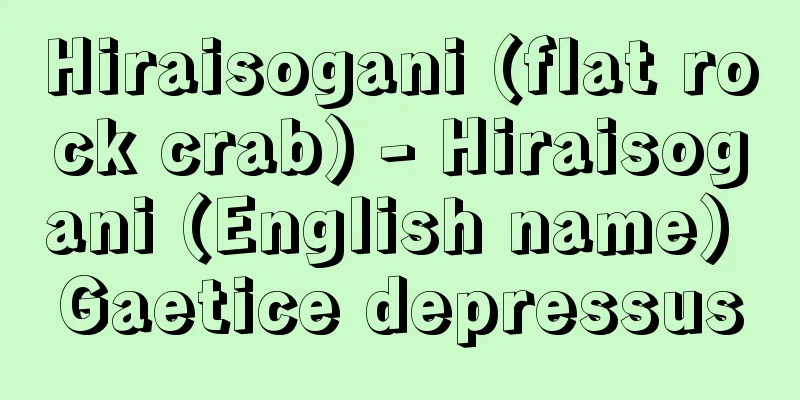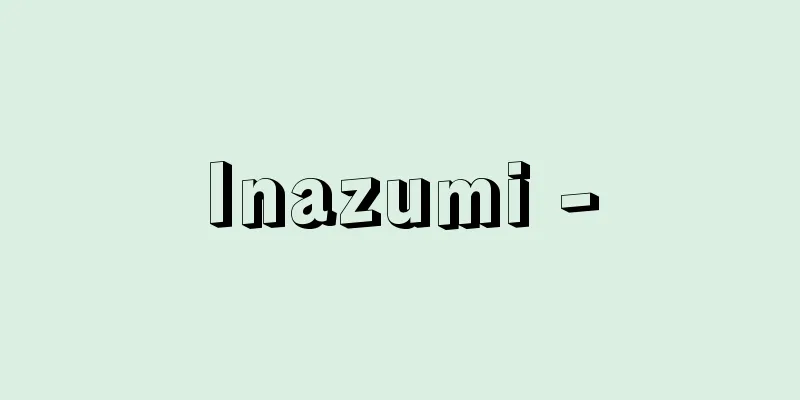Hanaoka mine

|
This mine was located in Odate City in northern Akita Prefecture. It is one of Japan's leading black ore mines. It was discovered in 1885 (Meiji 18) and silver was extracted there. In 1916 (Taisho 5), the Doyashiki deposit was discovered, and since then it has become one of the leading mines in the country. There are three deposits, Matsumine, Fukazawa, and Ezuri, and the amount of crude ore extracted was approximately 840,000 tons (1980). The ore was sent to smelters in Kosaka, Hosokura (Miyagi Prefecture), and Hikoshima (Yamaguchi Prefecture), where it was refined into gold, silver, copper, lead, zinc, iron sulfide, manganese, etc. It closed in 1994 (Heisei 6). [Reijiro Miyazaki] Hanaoka IncidentDuring World War II, of the 10,000-odd workers at the Hanaoka mine, 986 were Chinese who had been forcibly taken away. 140 died from hard labor, food shortages, abuse, and cave-ins. On the night of June 30, 1945, about 800 Chinese, excluding the sick, killed five night watchmen at the Nakayama dormitory of the Hanaoka branch office of Kajimagumi (now Kajima), and fled. All were brought back a week later, but 113 died from torture. The ringleaders were indicted on charges of wartime disturbance, and on September 11, after the war, the Akita District Court sentenced one to life imprisonment and 10 to prison terms of 10 years or less. The Japanese responsible parties were tried at the Far East Military Tribunal, where three were sentenced to death by hanging, one to life imprisonment, and two to 20 years' hard labor (all were later released on parole). Even after the war ended, conditions at the mine were poor, and another 180 Chinese died. The Japan-China Friendship Association returned the remains to China, and a monument to the friendship between Japan and China that will never again be fought and a monument to the Chinese martyrs were erected on the site. Chinese survivors and bereaved families subsequently formed the Hanaoka Victims Friendship Association. In 1989, the association issued an "open letter" demanding three things from Kajima: an apology, the establishment of a memorial hall, and compensation. In 1990, Kajima issued an apology, but refused to provide individual compensation, so a lawsuit was filed in the Tokyo District Court in 1995. However, as nearly 50 years had passed since the lawsuit was filed, the right to claim damages had lapsed, and the first trial ruling in 1997 resulted in the plaintiffs losing. In the second trial in 1999, the Tokyo High Court, using its authority, recommended a settlement in the protracted trial. In September 2000, the presiding judge presented Kajima with a settlement proposal that included the establishment of a victim compensation fund in China. In November, a settlement was reached when Kajima entrusted a total of 500 million yen to the China Red Cross and established the Hanaoka Friendship Fund. [Reijiro Miyazaki] [Reference item] |Source: Shogakukan Encyclopedia Nipponica About Encyclopedia Nipponica Information | Legend |
|
秋田県北部、大館市(おおだてし)にあった鉱山。わが国有数の黒鉱(くろこう)鉱山。発見は1885年(明治18)で、銀を採掘した。1916年(大正5)堂屋敷鉱床が発見され、以来全国でも屈指の鉱山に数えられるようになった。松峰、深沢、餌釣(えづり)の3鉱床があり、粗鉱採掘量は約84万トンであった(1980)。鉱石は小坂(こさか)、細倉(宮城県)、彦島(山口県)の各精錬所に送られ、金、銀、銅、鉛、亜鉛、硫化鉄、マンガンなどに精錬された。1994年(平成6)閉山。 [宮崎禮次郎] 花岡事件第二次世界大戦時、花岡鉱山の労働者1万数千人のうち、強制連行されてきた中国人労働者は986人を数えた。重労働、食糧不足、虐待、落盤により140人が死亡した。1945年(昭和20)6月30日夜、鹿島組(かじまぐみ)(現、鹿島)花岡出張所中山寮で病弱者を除く約800人の中国人が、宿直員5人を殺傷して逃亡。1週間後には全員が連れ戻されたが拷問により113人が死亡。首謀者は戦時騒擾(そうじょう)罪で起訴、終戦後の9月11日に秋田地裁で1人に無期懲役刑、10人に10年以下の懲役刑の判決がおりた。日本側の責任者は極東軍事裁判にかけられ、絞首刑3人、終身刑1人、重労働20年の刑2人の判決を受けた(のち全員仮出所)。 終戦後も鉱山の待遇は悪く、さらに180人の中国人が死亡。日中友好協会が遺骨を中国に返還し、現地には「日中不再戦友好碑」「中国殉難烈士碑」が建てられた。その後、中国の生存者、遺族が花岡受難者連誼会を結成。1989年に同会が「公開書簡」を発し、鹿島に対して、謝罪、記念館の設置、補償の3項を要求。1990年鹿島が謝罪を表明、しかし個人補償を拒否したため、1995年東京地裁に提訴。しかし、提訴まで50年近く経過していたため損害賠償請求権が消滅しており1997年に行われた1審判決では原告側が敗訴。1999年の2審で、長引く裁判に対して東京高裁が職権により和解を勧告。2000年9月裁判長が鹿島に、中国に被害者補償基金を設立するなどの和解案を提示。11月、鹿島が中国赤十字会に総額5億円を信託し、「花岡友好基金」を設立することにより、和解が成立した。 [宮崎禮次郎] [参照項目] |出典 小学館 日本大百科全書(ニッポニカ)日本大百科全書(ニッポニカ)について 情報 | 凡例 |
Recommend
Kankojiro - Kankojiro
...The name of a Chinese folk god, said to be the...
Amphoteric hydroxide
...In a narrow sense, it refers to compounds with...
Things - things
[1][一] Refers to objects with some form in general...
Merostomata
…(2) Xiphosura: Horseshoe crabs with only two gen...
Blower
… Although there is little difference between the...
Edged hand water basin - Ensakichozubachi
…The role of the chozubachi is to purify the mind...
Akimonto - Followers of Aki
…Mutual aid in rural areas was also cultivated by...
Myosotis sylvatica (English name) Myosotissylvatica
… [Yukio Taniguchi]. … *Some of the terminology t...
Hot spring heat release amount - Onsen Hounetsuryo
…Iceland is a good example of this. [Heat dissipa...
Shimousa Province
The old name of a province that stretched from no...
Odama-sama - Odama-sama
...Its characteristic is that it appears (1) in c...
Tarnow (English spelling) Tarnow
A city in the Lesser Poland Voivodeship in southe...
Halakhah
…The first is the interpretation of the Old Testa...
Archery - Archery (English spelling)
The word originates from the Latin arcus, meaning...
Muya salt fields
Irihama salt fields were built in Awa Province dur...






![Inakadate [village] - Inakadate](/upload/images/67caef9372dba.webp)


